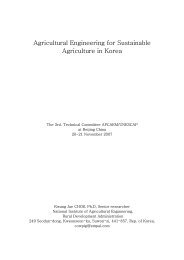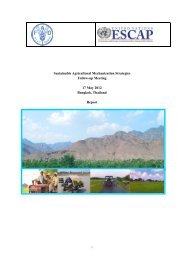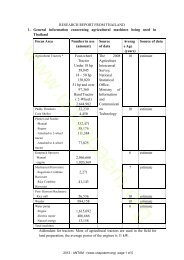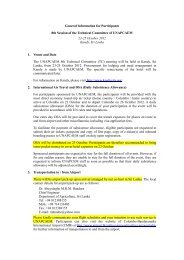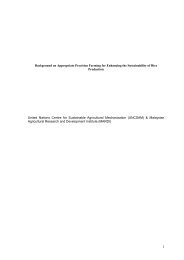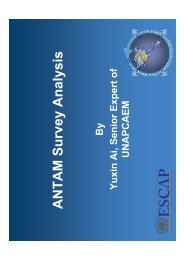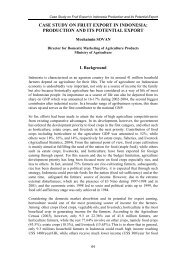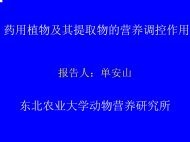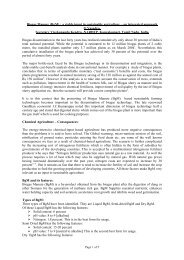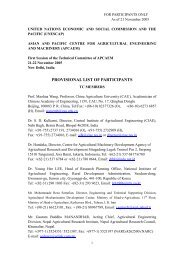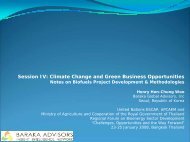Energy Saving Technology Development for Agricultural ... - CSAM
Energy Saving Technology Development for Agricultural ... - CSAM
Energy Saving Technology Development for Agricultural ... - CSAM
Create successful ePaper yourself
Turn your PDF publications into a flip-book with our unique Google optimized e-Paper software.
<strong>Energy</strong> <strong>Saving</strong> <strong>Technology</strong> <strong>Development</strong> <strong>for</strong> <strong>Agricultural</strong> Machinery andthe Greenhouse in KoreaKyu-Hong CHOI **Director/Senior Researcher, <strong>Agricultural</strong> Safety Engineering Division, Department of <strong>Agricultural</strong>Engineering, National Academy of <strong>Agricultural</strong> Science, Rural <strong>Development</strong> Administration, 150 Suin-Ro, Gwonseon-Gu, Suwon, Kyeonggi-Do, 441-857, Republic of Korea, E-mail: niaechoi@korea.kr1. IntroductionA recent rapid increase in the price of crude oil is deepening the instability of the energymarket, and the needs to develop new energy saving technologies and secure new renewableenergy sources that can substitute <strong>for</strong> fossil fuels are very urgent. Domestically, the new andrenewable energy accounts <strong>for</strong> 2.24% of the total primary energy in 2006, and the waste-toenergyaccounts <strong>for</strong> 76% of the new renewable energy which indicates that the waste-to-energytechnology is the most effective method <strong>for</strong> the supply and expansion of new renewable energy.The regulations on materials causing global warming have been strengthened by UNFCCC’sBali Roadmap, which may cause the ever-increasing pressure to Korea to commit the greenhousegas reduction target after 2012. <strong>Energy</strong> recovery from wastes is being internationally recognizedas a reliable method to reduce greenhouse gases to countermeasure the effects of climate change.New and renewable energy supporting by 2013 is estimated to increase by 3.8%, of which 84%will occupied by waste and biomass energy. In order to cope with the price rise of oil, it isnecessary to establish the 3Es paradigm that controls the environment, economy and energy inthe integrated manner. This will surpass the recycling-level of the 2Es era that integrates theenvironment and economy, and changes the policies.The greenhouse crop production in Korea has greatly threatened by not only its existence butalso making ends meet since 1990s due to the ever-increase of because of the ever-increases ofoil price <strong>for</strong> combustion. In fact, the greenhouse heating is mostly accomplished by fuelcombustion, which heats air and water. Light oil is the most common fuel type in both heatingsystem.The fuel cost occupies about 30 to 40% of the total crop production cost depending upon the1
crop type, which is higher than the ones in The Netherlands (15%), Israel (10%) and Japan (20%).The light oil price per liter, tax free price, was maintained within the range of 519 to 1,166 won,equivalent to approximately 0.5 to 1.1 dollars. More precisely, the price was 661 won in August,2007 and then increased up to 1,328 won in July, 2008. This was 100% increase compared withthe previous year. The quantity of light oil <strong>for</strong> greenhouse crop production (1,586 thousands kl)was about 64% of the total tax free fuel in agricultural production (2,478 thousands kl). Thisexplains that the greenhouse crop production was considerably relied on the tax free oil and thetax free oil price was also influenced by the existence of greenhouse farming. Overall, the fuelprice is the most important factor in determining the greenhouse farming industry profitable.To trans<strong>for</strong>m this greenhouse farming industry extremely sensitive into less sensitive to thefuel price, the policies have focused on how to reduce the greenhouse heating cost through thetechnology development of energy saving and alternative heating systems. RDA has providedinnovative solutions to release the economical burden of the employers in the greenhousefarming groups. Some of our outstanding research achievements <strong>for</strong> the past few years will befollowed.2. <strong>Energy</strong> <strong>Saving</strong> Technologies2-1. Exhaust heat recovery system <strong>for</strong> hot air heaterHot air heater with light oil combustion is used as the most common heater <strong>for</strong> greenhouseheating in the winter season. However, exhaust gas heat discharged to atmosphere through chimneyreaches up to 10~20% of total heat capacity of the oil burred. In order to recover the heat of thisexhaust gas and to use <strong>for</strong> greenhouse heating, the heat pipe type exhaust heat recovery system wasmanufactured and tested in this experiment. The system consisted of a heat exchanger made of heatpipes, Ø 15.88x600mm located rectangular box, an air suction fan and air ducts. The number of heatpipe was 60, calculated considering the heat exchange amount between exhaust gas and air and heattransfer capacity of a heat pipe (Figure 1).The working fluid of heat pipe was acetone because acetone is known <strong>for</strong> its excellent heattransfer capacity. The system was attached to the exhaust gas path. According to the per<strong>for</strong>mancetest it could recover 53,809 to 74,613kJ/h depending on the inlet air temperature of 15 to -12℃ at airflow rate of 1,100 m3/h. The temperature of the exhaust gas left the heat exchanger dropped to 100℃from 270 after the heat exchange between the suction air and the exhaust gas.2
Fig. 1 Exhaust heat recovery system with heat pipe unit attached to the hot air heater2-2. Waste heat recovery system <strong>for</strong> an agricultural product dryerThe heat recovery system was initiated to recover discharged waste heat from a drying chamberin an agricultural product dryer and recycle it as heat source to save the drying cost. It consists offive components, which are drying chamber, fan, burner, circulation pump and heat exchanger madeof fins and tubes. For the per<strong>for</strong>mance test, the heat balance analysis on the dryer and dryingexperiments using fresh peppers were conducted (Figure1). The amounts of fuel consumed by aconventional dryer and the heat recovery system attached to a conventional dryer were compared.According to the heat balance analysis on a conventional dryer, heat of exhaust gas, heat ofdischarged drying air from a drying chamber, and convection heat loss were about 14%, 77% and 9%,respectively. In the case of the heat exchanger attached to a dryer, air temperature at an inlet andoutlet of the discharged section were 55~60ºC and 41~43ºC, respectively. Air temperature at an inletand outlet of the suction section was 25~28ºC and 41~43ºC, which could supply 41~43ºC air to thedrying chamber. When red pepper was dried, the heat exchanger could recover the amount of heat(2,200~3,000kcal/h) from waste air heat of 4,700~6,000kcal/h. The recycled heat amount was 47%of total heat input of the dryer and 64% of waste heat discharged to atmosphere. In comparison to theconventional dryer, the drying time of red pepper was significantly reduced, and the drying cost andfuel consumption were reduced by 21% and 43%, respectively (Figure 3).H e at(M J )8007006005003400300200100(100%)(74%)(47%)
Fig. 2 Heat recovery <strong>for</strong> agricultural dryerFig. 3 Heat balance of heat recovery system2-3. Automatic rolling shutter <strong>for</strong> thermal vinyl tunnelThe idea of heating space reduction is not new concept in energy saving technology development.In fact, in the southern province of Korea, the greenhouse heating is not necessarily required butspace reduced due to relatively warm weather during the winter season. In addition, the temporaryvinyl tunneling inside greenhouse was found to protect crops from frosting during the winter season.However, covering and removing vinyl thermal tunnel every night and morning required a lot oflabors and only applied in warm southern region.There<strong>for</strong>e, we developed the new opening and closing method <strong>for</strong> the thermal tunnel curtain <strong>for</strong>all greenhouse cultivation crops to reduce this tedious labor input. This new method does not requiremanpower <strong>for</strong> the opening and closing of the thermal tunnel curtain, thereby cutting down thegreenhouse heating cost during the winter by as much as 70%. The new thermal tunnel system is anautomatic rolling shutter (ARS) <strong>for</strong> double layer PE film. It consists of several pipe holders withthree-point supporting roller, an aluminum pipe of Ø25 mm, tunnel frames, tunnel hangers, one DCmotor and a double layered PE film. One edge of double layered PE film is folded and the other isseparated. The folded edge is fixed on the surface of this aluminum pipe and the twofold PE film iswound on the surface. In addition, each vinyl sheet of the separated edge is put on the tunnel frame.And then <strong>for</strong> the smooth operation of vinyl opening & closing, the steel wire with the weight over0.3kg/m is fixed to the end tip of each vinyl sheet in the longitudinal direction of thermal tunnel(Figure 4 and 5).4
Fig. 4 Design of Automatic Rolling shutterFig. 5 Installation of Automatic Rolling ShutterThe thermal insulation effects of thermal tunnel is showed as the temperature difference betweentunnel air and ambient air (Figure 6). The ARS thermal insulation effect on large and small tunnelswas 5.3±0.6 and 7.4±0.6ºC, respectively. The elapsed time <strong>for</strong> the opening and closing of thermaltunnel was measured and then compared to the usage of human labor <strong>for</strong> a greenhouse area of 0.1ha.The elapsed time using the ARS was 10 minutes, while human labor required 60 minutes. The energysaving effect of the thermal tunnel was analyzed in comparison to the single span greenhouse5
without thermal curtain. The conventional hot air heater was employed in the controlled greenhouseas a heat source. In the thermal tunnels, the conventional hot water boiler was employed. The energycosts of large and small tunnels were 64% and 70%, which were less than the ones of the controlledgreenhouse.Temperature(℃) .15.010.05.00.0Small tunnel airLarge tunnel airGreenhouse air with large tunnelGreenhouse air with small tunnelAmbient air-5.017:00 19:00 21:00 23:00 1:00 3:00 5:00 7:00 9:00Time of dayFig. 6 Thermal insulation effect of thermal tunnel2-3. <strong>Energy</strong> saving dehumidifier <strong>for</strong> greenhouseDuring the winter season in Korea, the relative humidity inside a greenhouse at night oftenexceeds 90% because air temperature inside a greenhouse is usually controlled by a heater andclosed windows to minimize heat loss. Thereby, it requires the use of a dehumidifier that canmaintain the optimal humidity levels of 70 to 80 percents to provide the better growth condition <strong>for</strong>greenhouse crops. Such a high humid condition could cause the development of pest, such as, insects,fungi or diseases. However, the usage of most conventional dehumidifiers <strong>for</strong> low temperaturedehumidification is limited because their per<strong>for</strong>mance could be degraded by frost accumulation onthe surface of the evaporator coil.To control the relative humidity of air inside the greenhouse, the dehumidifier functioned by arefrigeration cycle was designed and manufactured in the National Academy of <strong>Agricultural</strong> Science(NAAS), Rural <strong>Development</strong> Administration (RDA) of Korea. The dehumidifier developed inNAAS has separated condenser and evaporator in the heat exchanger part in order to increase the6
dehumidifying capacity under the low temperature. When temperature and relative humidity ofincoming air to the dehumidifier was 15~25ºC and 70~95%, the condensed water was 5.7~7.0 kg/hr.The relative humidity difference was not greater than 5 percent at various locations inside thegreenhouse due to proper distributing of dehumidified air through vinyl duct. <strong>Energy</strong> saving effectwas contributed by dehumidified air with increased temperature, and the latent heat was12,000kcal/hr that was about 10 percent of the total heating load in the greenhouse sized of 0.1ha(Figure 7).Fig. 7 The principle of the humidifier and its prototype2-4. Fully-open roof system <strong>for</strong> soft-covered multi-span greenhouse (1-2W Type)To ensure year-round production of high quality agricultural crops, the fully-open-roof system <strong>for</strong>the multi-span arch-typed greenhouse was developed to improve natural ventilation inside agreenhouse during the summer. The fully-open-roof system was designed using the winding rooffilm drive, and the roof film can resist the wind velocity of up to 45m/s by four-edge fixation withchanging band tension. This system can be used in soft films, such as a vinyl, fluoric film and textileetc. without opening stroke limitation of the roof. The opening and closing of roof vinyl wasdesigned as winding type <strong>for</strong> the fully-open-roof in the multi-span arch-type vinyl house. The guideroller moving along with guide frame, which constructed at both ends outside the greenhouse,maintained the direction of the winding bar during its operation. It was also connected to the windingbar and motor (Figure 8).On the other hand, the band of resisting lift <strong>for</strong>ce caused by wind was regularly located along withthe roof of the multi-span greenhouse to maintain roof stability. An eccentric disk cam and its shaft7
connected to the driving motor were also installed in the gutter, and the tension of the band wascontrolled by half rotation of the disk cam. The outside diameter of the aluminum winding bar wasfixed at 50mm, and the capacity of the winding motor was DC-24V-80W in the 100m lengthgreenhouse. In the gutter, the settling part of the winding bar (A6063 aluminum) with 248.4mm 2 ofthe cross sectional area located at both edges of the gutter maintained the tension of the vinyl whenthe roof vinyl was fully closed. Accordingly, when the roof was closed, the winding bar in the slot ofthe settling part can be protected from the slot without deviation caused by wind, and the roof filmincreased light transmission by vinyl tension without the crumpled sheet (Figure 9).As results, the maximum electric power loads of the winding bar were 30.5W, 38.8W and 33.1Wunder the free load, the opening load and the closing load of the roof, respectively. Considering theopening net-load of 8.3W, the predicted net-load <strong>for</strong> 100m length of the winding bar was 25.1W,with no significant difference compared with the theoretic net load of 27.3W electric power. Theeffect of natural ventilation on the internal temperature and humidity was also investigated.Fig. 8 The schematic diagram of gutter assemblyFig. 9 The prototype greenhouse covered by PE and installed with three-span of 100m8
2-5. Improvement of heat exchanger in a hot-air heaterA widespread use of agricultural air heaters (about 178,430) has lead the increase of greenhouseheating cost up to 574 billion won per year in Korea. There<strong>for</strong>e, this study was conducted to promotethe energy consumption efficiency by replacing a circular straight arrangement tube tank in aconventional hot air heater with a hexagonal stagger arrangement tube bank (Figure 10). Theper<strong>for</strong>mance of improved and conventional hot air heaters was compared.As a result, the energy consumption efficiency of a hot air heater with a hexagonal staggerarrangement heat exchanger developed in this study was 11%, which was higher than that of aconventional hot air heater. This indicates the heating energy saving rate was increased up to 14.3%(Figure 11, Table 1). Furthermore, it is expected to save about 82.1 billion won per year (574 billionwon/yr × 0.143) by using a hot air heater with a hexagonal stagger arrangement heat exchangerdeveloped in this study.Fig. 10 Rearrangement of a tube bank in a heat exchangerFig. 11 Heat utilization efficiency and its measurement9
Table 1 Analysis of energy consumption efficiency <strong>for</strong> conventional and improved hot air heatersItemsConventional hot air heater(Circular straightarrangement)Improved hot air heater(Hexagonal staggerarrangement)Air flow rate Right 10,558 11,514(m 3 /h) Left 11,120 11,667The amount of heat (kcal/h m 2 ) 14,192 18,873<strong>Energy</strong> consumption efficiency (%) 76.8 87.8Combustion efficiency of burner (%) 90.4 90.5Temperature (Deg)Right 57 59Left 56 583. New and Renewable <strong>Energy</strong> Technologies3-1. Geothermal heat pump system with thermal storage tank and horizontal heat exchangerThe geothermal heat pump system uses the earth as a heat source in heating mode and a heat sinkin cooling mode. This study was conducted to heat/cool farm facilities and obtain basic data <strong>for</strong> apractical application of the horizontal-geothermal heat pump system. The horizontal-geothermal heatpump system with 10RT (Refrigeration Ton) scale was installed in a greenhouse sized of 6m × 40m(Figure 12). The heating and cooling per<strong>for</strong>mance of this system was estimated.When the temperature inside the greenhouse was set to 10ºC, the maximum heating load of thegreenhouse was calculated as 39.91kW at an ambient temperature of -15ºC. This maximum heatingload corresponded to about 10RT. The horizontal-geothermal heat pump used in this study had theheating COP of 4.57 at a soil temperature of 14ºC with a depth of 1.75m and the heating COP of 3.75at a soil temperature of 7ºC with the same depth. The stratification of heat tank was appeared withinthe entire heat rejection period.According to the per<strong>for</strong>mance test from 2005 through 2007, the cost of heating energy was savedup to 78% when the horizontal-geothermal heat pump was used at farming households. For arecommendation to the new renewable energy policy of the Ministry of Knowledge Economy, wecontinue to distributing this heat pump to the gardening facilities sized of 91.1ha with the budget of10
111 billion won in 2008 and this will be continued in the future.Fig. 12 Vertical-typed geothermal heat pump system <strong>for</strong> greenhouse heating3-2. Solar energy heating system <strong>for</strong> greenhouseSeveral attempts have been made to use solar energy <strong>for</strong> supplemental greenhouse heating source<strong>for</strong> the last three decades. Successful outcomes came from solar hot water system <strong>for</strong> domesticpurposes but practical or economically feasible results are hard to be justified considering theinstallation price of solar greenhouse heating system. Though considerable subsidy is provided, theprice is still too high to be accepted by greenhouse owners.Solar panel water heating system <strong>for</strong> greenhouse heating collects solar thermal energy heat, storesthe heat in hot water <strong>for</strong>m and circulates the hot water during night time. Another area of solarenergy uses in greenhouse production is solar PV system <strong>for</strong> power source of greenhouse windowsoperation. DC electricity produced by the solar PV system of 150W photo voltaic panel plus 2kWcapacity battery could open and close 19 windows automatically and simultaneously <strong>for</strong> fiveconsecutive days under no battery charging. Though most greenhouse has no difficulty to reachelectricity, but needs of this PV system are always existed in remote regions and emergency purposes.This solar PV system is the first application in agricultural productions to use solar energy as powerto operate motors (Figure 13).11
Fig. 13 Greenhouse window opening using the solar PV system4. Korea’s Green Growth StrategyCurrent “Low Carbon, Green Growth” is a key catchphrase in Korea. Since the vision wasproclaimed in August 2008, the Korean government has launched a series of bold green initiatives tohelp Korea leapfrog into a low carbon society.The 1 st National Basic <strong>Energy</strong> Plan (2008-2030) and Comprehensive Plan on CombatingClimate ChangeThe concept of Green Growth was integrated into the national energy and climate change plans.National energy plan, which was passed on 20 August 2008, has set the goal of increasing the shareof renewable energy to 11% by 2030. Climate change plan is the most comprehensive and ambitiousplan Korea has developed in addressing climate change which includes adaptation and internationalef<strong>for</strong>ts.‘Green New Deal’ Stimulus PackageAnnounced on 6 January 2009, the Stimulus Package is an investment plan of 50 trillion KRW(385 billion USD) <strong>for</strong> the next 4 years on 9 key green project and some spillover projects that willcreate 956 thousand new green jobs. 2009 budget (including tax benefits) is approximately 2.6% ofthe annual GDP. The budget is already being implemented and proposed additional budget requestwill take the total number much higher.9 Key project include 1) revitalization of 4 major rivers, 2) building green transportation, 3)building database on national territory and resources, 4) water resource management, 5) green carand cleaner energy program, 6) resource recycling program, 7) <strong>for</strong>est management & biomass12
program, 8) green home, office and school, 9) greener landscape and infrastructure.Comprehensive R&D Plan on Green <strong>Technology</strong>Endorsed by the National Committee on Science & <strong>Technology</strong> announced on 13 January 2009,the Plan called <strong>for</strong> a two-fold increase of R&D spending on Green <strong>Technology</strong> by 2012 (769 millionUSD in 2008) on 27 key technology areas such as climate change prediction & modeling,photovoltaic solar panel, LED, waste regeneration, carbon capture and storage, etc.5. SummaryKorea government has been paying more and more attention to the issues of agricultural energyand environmental problems. Technologies <strong>for</strong> energy saving and renewable energy must meet social,economic, and environmental objectives, as well as being af<strong>for</strong>dable and cost effective. For aninstance, energy conversion from sludge and wastewater is very complex technology depending onthe economic factors. It is important to find more effective technologies which treat wastewatereffectively while avoiding production of poisonous and harmful substances on environment.Recently, “<strong>Energy</strong> Self-supporting Green Village” project which comprehensively utilizes biomasswith strong ties between the community and local stakeholders is going like clockwork by supportingthe Ministry <strong>for</strong> Food, Agriculture, Forestry, and Fisheries and the Ministry of Knowledge Economy.<strong>Technology</strong> developments in Green Village include methane fermentation, gasification of sludge andbiomass-converting system suitable <strong>for</strong> the local region. This project covers the provision ofin<strong>for</strong>mation and capacity-building in the different regions.The government can influence changes in three principal areas of the energy system: energy use,industrial structure, and energy production. The tools which the government may use to exert itsinfluence are: support to research and development (R&D), demonstration and in<strong>for</strong>mationdissemination, administrative policy measures, and economic incentives. These instruments may beapplied separately or in combination. However, there is a need of coherent and effective policy <strong>for</strong>supporting the energy saving technology and renewable energy development.The paper examines the technology development of agricultural sector, focusing on measures <strong>for</strong>reducing the use of energy and promoting renewable energy in Korea. <strong>Agricultural</strong> energy has playeda small role in Korea’s energy balance so far, accounting <strong>for</strong> about 1.8 percent of the total consumerenergy.Improving greenhouse heating system that could reduce the greenhouse heating cost is one of the13
hot topics <strong>for</strong> people in greenhouse industry. Enormous ef<strong>for</strong>ts on every aspect, such as, recycle ofwaste heat from a conventional oil heating system, solar energy utilization and geothermal heatpump system developed in NAAS/RDA, have been made, and some progress in efficient energyutilization ways <strong>for</strong> the greenhouse heating system was accomplished. In order to escape from excessdependency on conventional heating resource, which is oil combustion, the continuous ef<strong>for</strong>t is verycritical to ensure the success of greenhouse farming in Korea.14



